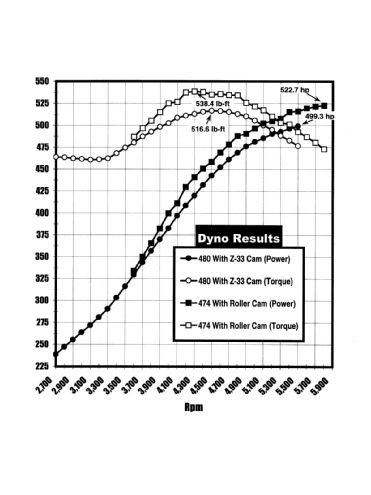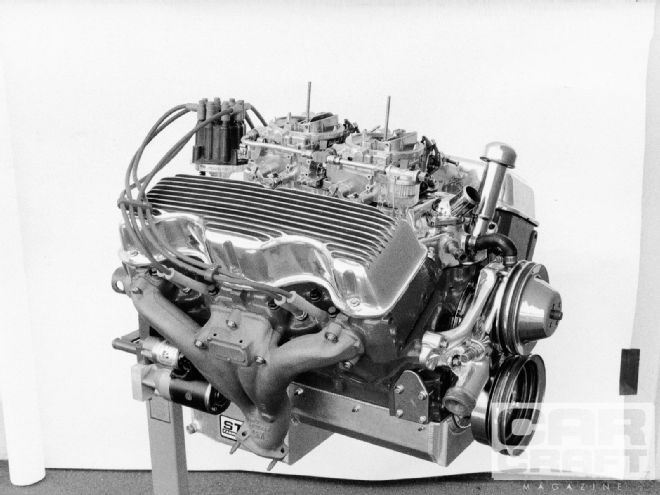
With its distinctive scalloped valve-covers, Chevy's Mark I 348/409ci big-block blazed a legendary trail across America's race tracks during the early '60s. Today, it retains a faithful following among resto guys and nostalgia racers. Although finding parts for an engine that ended production in 1965 might seem like a chore, in reality the 348/409 is a transitional engine that shares design characteristics with small-block and newer big-block engines, many of whose parts bolt into the 348/409 with few or no mods.
Major (and unique) components like heads and blocks can still be found through enthusiast publications, swap meets, and truck salvage yards. There's also the one-stop 348/409 niche specialist CH Enterprises, which offers all internal components plus rebuildable cores. CH also maintains complete 409-based engine cylinder-head porting, engine machining, and engine assembly services. Owner Curt Harvey has updated the venerable engine using today's technology, developing modern cam profiles and big-inch stroker kits. With high-perf 409 heads, a relatively mild mechanical cam, and 10.0:1 forged pistons, a 474ci street stroker makes about 500 hp and 500 lb-ft of torque. Sound intriguing? Let's take a closer look at this classic motor and what it takes to build it into a 474ci stroker ready for the 21st century.
Blocks You Can't Knock-Off
W-Series or Mark I big-blocks were built in three different displacements:
Ci Year Bore Stroke Con Rod Length 348 '58-'61 4.125 3.25 6.125 409 '61-'65 4.3125 3.50 6.010 427 (Z-11, rare!) '63 4.3125 3.65 6.135
These days, Harvey sees more 409s than 348s. Either core costs about $400 cleaned and magged, so it pays to find and build the larger 409. As Harvey puts it, "Why build a 283 when you can move up to a 350?"
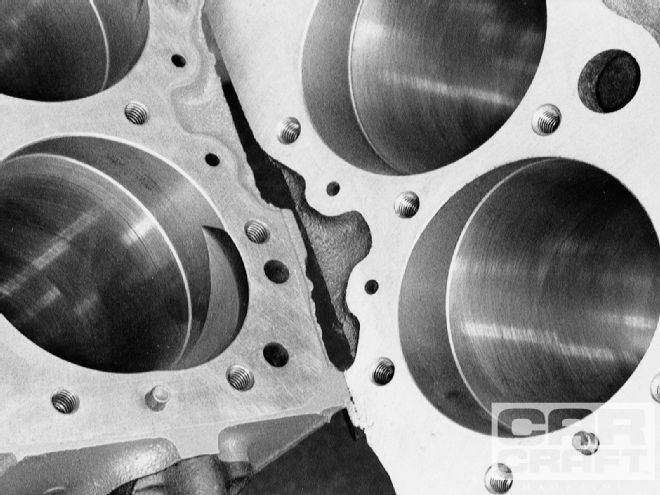 All 348 and truck 409 blocks have an extra exhaust valve notch to unshroud the valve. This helps improve breathing engines under 12.0:1 compression. The unique deck surface is nonperpendicular relative to the rod throw's vertical centerline.
All 348 and truck 409 blocks have an extra exhaust valve notch to unshroud the valve. This helps improve breathing engines under 12.0:1 compression. The unique deck surface is nonperpendicular relative to the rod throw's vertical centerline.
Although some 348 blocks have thick cylinder walls, most cannot be bored out to the larger 409 diameter. ID a 409 block by the last three digits of the block casting number that's located on the rear driver-side bellhousing flange:
Year 409 Block Casting Nos. '61 723 '62 068 '63 814 (also 427 Z-11) '64 422 '65 656
Cylinder-wall thickness varies widely because casting techniques back then weren't up to current standards. Usually 0.030-over is no problem, but 0.060 requires sonic-checking the block (minimum acceptable wall thickness is 0.110-inch). Occasionally, Harvey gets a block that can safely go 0.132-over-but don't hold your breath!
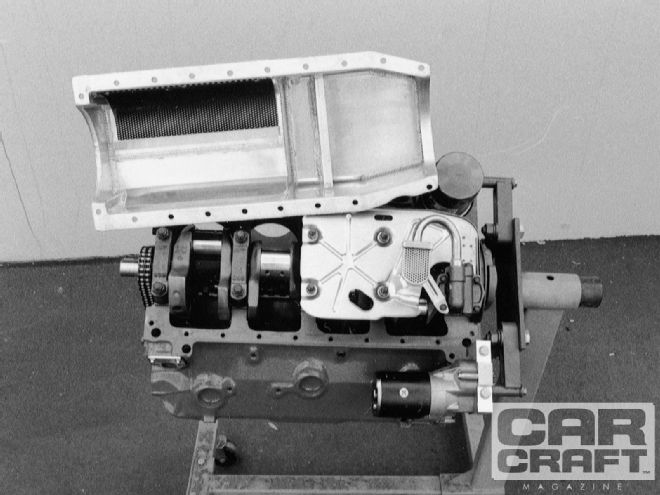 The '65-'74 big-block Vette windage tray (PN 3967854) fits stock 409 pans. Steff's internally baffled aluminum competition pan doesn't need a separate tray. CH has the right pick-up for use with modern V-8 oil pumps. A PN 3952301 adapter accepts a spin-on AC PF-25 or PF-35 oil filter.
The '65-'74 big-block Vette windage tray (PN 3967854) fits stock 409 pans. Steff's internally baffled aluminum competition pan doesn't need a separate tray. CH has the right pick-up for use with modern V-8 oil pumps. A PN 3952301 adapter accepts a spin-on AC PF-25 or PF-35 oil filter.
Retain the two-bolt main-caps using GM Mark IV big-block main cap bolts plus hardened washers or equivalent ARP bolts and studs. The oiling system is typically Chevy-reliable. All you need is a Melling M55HV small-block high-volume oil pump. Big-block pumps also fit, but they'll suck the stock pan dry. A late big-block heavy-duty oil pump driveshaft (PN 3865886) works.
Getting Some Heads
Perhaps the most striking feature of the 409 is its unique cylinder heads and their staggered valve arrangement that in turn mandates a distinctive set of scalloped valve covers. (The best-looking, best-fitting, currently available aftermarket covers are made by Moon, as shown in the lead photo.) The weird combustion chambers displace 9 cc; like a flathead, most of the effective chamber volume is in the block. McCord made the best head gaskets (note the past tense), but CH still has a stash of them.
Standard 348 heads use 1.94/1.66 valves and are generally not useful for performance applications. High-perf 348 and low-perf 409 heads have 2.06/1.72 valves; if larger 2.19-inch valves are installed, their intake runners typically flow about 225 cfm stock and are capable of supporting a 450hp engine. High-perf 409 heads have 2.19/1.72 valves, flow 255-260 cfm on the intake side, and can support up to 520 hp as delivered; expect to shell out $500-$800 for a good set of cores.
High-perf Z-11 heads are in a class by themselves: Capable of supporting 600 hp, their raised intake runners feature a nearly contemporary straight-shot valve bowl approach and flow about 300 cfm stock-better than many modern performance big-block cylinder heads. Would you believe $10,000 per pair-if you can find a set!
Not the Same Old Grinds
Hydraulic and mechanical flat-tappet and mechanical roller cams are readily available. CH will have dedicated 348/409 hydraulic roller cams and lifters by the time you read this. Although they appear to fit, standard small-block roller-lifter guideplates are a tad short for the 348/409 and may bind in a running engine.
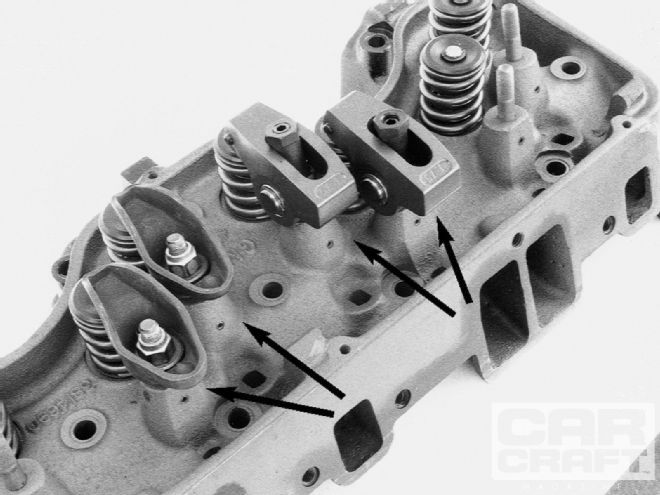 Stock 348/409 stamped rockers look like Rat rockers, but modern big-block parts won't fit their smaller top-diameter stock rocker studs. CH has 1.75:1 roller rockers. Later high-perf heads with factory-pinned press-in studs (arrows) are OK through 300-psi open valvespring pressures.
Stock 348/409 stamped rockers look like Rat rockers, but modern big-block parts won't fit their smaller top-diameter stock rocker studs. CH has 1.75:1 roller rockers. Later high-perf heads with factory-pinned press-in studs (arrows) are OK through 300-psi open valvespring pressures.
Because of the slanted deck, the exhaust valve opens toward the cylinder wall: Passenger-car blocks are limited to 0.650-inch lift max; the truck blocks with the large exhaust notch take up to 0.730-lift. An oversize 1.88-inch valve hits at only 0.300-lift! But you don't want to go back to an old "resto" grind that exactly duplicates early '60s specs, either. Even the 409/425hp and 430hp Z-11 mechanical cams were ground with a 113 1/2-degree lobe displacement angle (LDA). Stick that in a 3.55:1-geared, 4,000-pound sedan-ugh!
CH's 499hp 474ci engine uses an Isky Z-33 grind, essentially the 425hp mechanical cam (0.560-inch lift, 250-degrees duration at 0.050-inch tappet lift), but ground with a 110-degree LDA and installed on a 107-degree intake centerline. This wakes that baby right up. The next step up is a mild Isky solid roller that specs out at 0.620-inch lift, 248-degrees 0.050-inch tappet lift duration, 110-degree LDA, and 107-degrees intake centerline. Isky No. 3105 valvesprings work with the mechanical flat-tappet cam. Use Comp Cam's No. 916 small-block Chrysler spring and 10-degree titanium retainer with the roller cam, along with heavy-duty screw-in rocker studs.
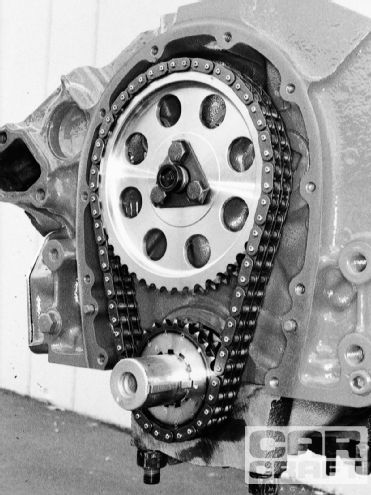 The timing chain sprockets interchange with small-block parts, but the chain is longer. CH offers this multi-keyway full-roller timing chain set. Peter Jackson still makes a geardrive.
The timing chain sprockets interchange with small-block parts, but the chain is longer. CH offers this multi-keyway full-roller timing chain set. Peter Jackson still makes a geardrive.
Only the Z-11 heads use screw-in rocker-arm studs and guideplates stock. Every other 348/409 has pressed-in studs. Starting in November 1961, GM went to pinned, hardened studs on the high-perf heads. At 1.75:1, the stock rocker arm ratio is even higher than the late big-block's 1.7:1. The stock rocker stud's top 3/8-24 threads are like a small-block, but the rocker arms and balls are unique to the 348/409. CH highly recommends moving up to its full-roller "real 1.75:1 ratio" 409 rockers, as current replacement stamped steel rockers are of poor quality (the tooling is worn-out and the heat-treat is garbage).
Happiness is a Long Stroke
In yesterday's heavy cars, the short-stroke 409 doesn't perform like a typical big-block, needing steep gears to get out of the hole. Fortunately, there's plenty of room in the block to increase the stroke. The 348/409s have the same bore-spacing, 2.20-inch rod journals, and rear main seal as the later Mark IV big-block. The front snout and seal is the same as a small-block. Only the 2.5-inch main-bearing journal diameter is unique. So the plan is to turn down the 2.75-inch big-block main journals to the 409's size, rework the snout to the 409/small-block pattern, and contour-grind the counterweights slightly to clear the oil pan. Drop in a suitably modified 4-inch stroke 454 crank with a 0.030-inch overbore and you get 474 ci-plus the missing low-end torque.
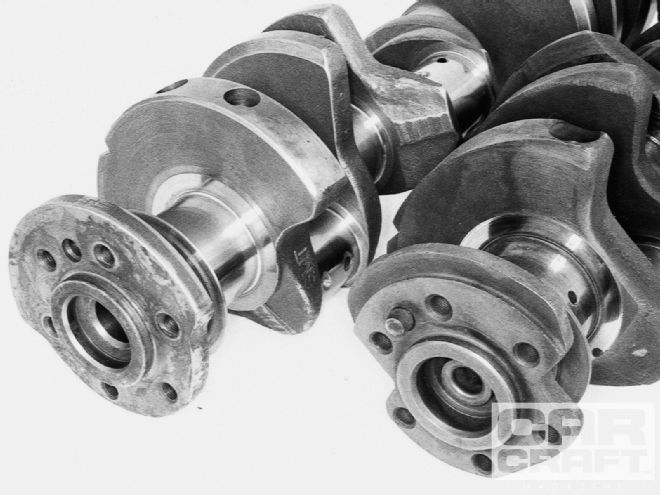 If using an original 348/409 crank (left) with a modern TH350/400 auto trans flexplate, bevel the crank's outer edge slightly for clearance to match the "step" in the 454 crank (right).
If using an original 348/409 crank (left) with a modern TH350/400 auto trans flexplate, bevel the crank's outer edge slightly for clearance to match the "step" in the 454 crank (right).
A 454 crank requires external balance weights. CH sells an aftermarket externally balanced small-diameter 7-inch SFI-legal 400 small-block damper that fits the now-small-block-sized 454 front crank snout while clearing the 409 water pump (however, its as-delivered timing mark location doesn't match the 409's timing pointer). At the flange-end, just use a 454 flexplate or flywheel.
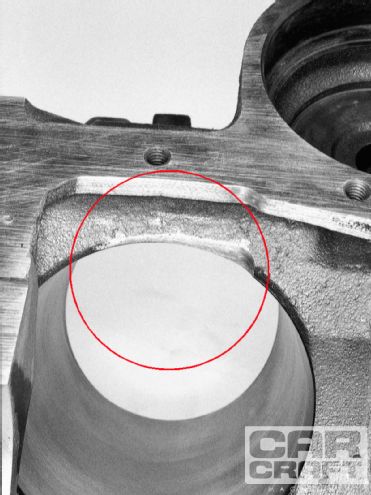 A 6.75-inch low-perf small-block damper (GM 6272221) can replace an original damper on 348/409 cranks or internally balanced modern big-block cranks, but the timing mark is 10 degrees off (remark as needed); 8-inch dampers won't clear the water pump.
A 6.75-inch low-perf small-block damper (GM 6272221) can replace an original damper on 348/409 cranks or internally balanced modern big-block cranks, but the timing mark is 10 degrees off (remark as needed); 8-inch dampers won't clear the water pump.
Mate the 454 crank with CH's stroker pistons using modern big-block 3/8-inch-bolt rods-unlike the 7/16-inch forgings, they clear the block. With CH's custom replacement forged pistons, these longer and stronger modern rods are also a desirable upgrade for stock-stroke 348s and 409s.
Where's the Fire?
Pass the Gas
You can get serious heartburn trying to pass gas into and out of a 409. All the stock intake manifolds are weak and don't flow well. The production intake manifold runner-to-cylinder head entry forms a restrictive V-shaped intersection and porting them out only sharpens the V. An average ported intake runner actually flows about 10 percent less than a stock port through 0.400-inch lift! Port the exhaust and leave the intake side (especially the floor) alone (bowl work's OK). Serious guys will step up to a sheetmetal intake.
On the exhaust side, Hooker still offers a header set (PN 217) for '58-'64 full-size passenger cars. Most guys default to a set of production high-perf exhaust manifolds. If you can find them, pull $650 out of your wallet.
Gettin' the Digits
There's many a late model that'll have hell to pay going up against a stroked 409. With the Isky Z-33 mechanical cam, a 10.0:1-compression 481 (0.060-over 409 with a 4-inch-stroke 454 crank) equipped with headers and two late-style 600-cfm Carter AFBs installed atop the stock high-performance 2x4 high-rise made 499.3 hp at only 5,500 rpm, and 516.6 lb-ft of torque at 4,500 on pump premium unleaded gas with 34 degrees of spark advance. It produced in excess of 450 lb-ft throughout the entire test range, with over 500 lb-ft on tap between 4,000 and 5,100. With 41 degrees of timing, the Isky 0.620-inch lift roller and 1-inch carb spacer plates, an otherwise similar 474 (only 0.30-over) upped the output to 522.7 hp at 5,800 rpm and 538.4 lb-ft of torque at 4,300. Got any tree stumps that need yanking?
